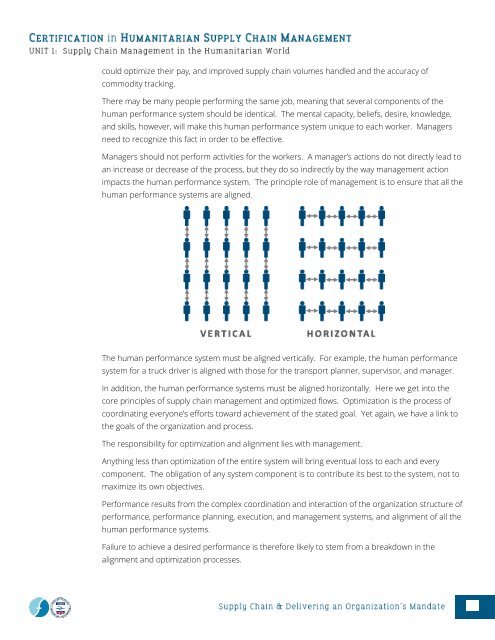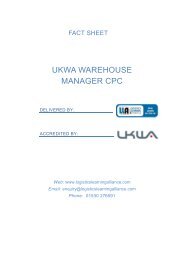CHSCM 3.0 - Unit 1 - SCM in the Humanitarian World
Learning Materials for Unit 1 of the Certification in Humanitarian Supply Chain Management (CHSCM).
Learning Materials for Unit 1 of the Certification in Humanitarian Supply Chain Management (CHSCM).
Create successful ePaper yourself
Turn your PDF publications into a flip-book with our unique Google optimized e-Paper software.
could optimize <strong>the</strong>ir pay, and improved supply cha<strong>in</strong> volumes handled and <strong>the</strong> accuracy of<br />
commodity track<strong>in</strong>g.<br />
There may be many people perform<strong>in</strong>g <strong>the</strong> same job, mean<strong>in</strong>g that several components of <strong>the</strong><br />
human performance system should be identical. The mental capacity, beliefs, desire, knowledge,<br />
and skills, however, will make this human performance system unique to each worker. Managers<br />
need to recognize this fact <strong>in</strong> order to be effective.<br />
Managers should not perform activities for <strong>the</strong> workers. A manager’s actions do not directly lead to<br />
an <strong>in</strong>crease or decrease of <strong>the</strong> process, but <strong>the</strong>y do so <strong>in</strong>directly by <strong>the</strong> way management action<br />
impacts <strong>the</strong> human performance system. The pr<strong>in</strong>ciple role of management is to ensure that all <strong>the</strong><br />
human performance systems are aligned.<br />
The human performance system must be aligned vertically. For example, <strong>the</strong> human performance<br />
system for a truck driver is aligned with those for <strong>the</strong> transport planner, supervisor, and manager.<br />
In addition, <strong>the</strong> human performance systems must be aligned horizontally. Here we get <strong>in</strong>to <strong>the</strong><br />
core pr<strong>in</strong>ciples of supply cha<strong>in</strong> management and optimized flows. Optimization is <strong>the</strong> process of<br />
coord<strong>in</strong>at<strong>in</strong>g everyone’s efforts toward achievement of <strong>the</strong> stated goal. Yet aga<strong>in</strong>, we have a l<strong>in</strong>k to<br />
<strong>the</strong> goals of <strong>the</strong> organization and process.<br />
The responsibility for optimization and alignment lies with management.<br />
Anyth<strong>in</strong>g less than optimization of <strong>the</strong> entire system will br<strong>in</strong>g eventual loss to each and every<br />
component. The obligation of any system component is to contribute its best to <strong>the</strong> system, not to<br />
maximize its own objectives.<br />
Performance results from <strong>the</strong> complex coord<strong>in</strong>ation and <strong>in</strong>teraction of <strong>the</strong> organization structure of<br />
performance, performance plann<strong>in</strong>g, execution, and management systems, and alignment of all <strong>the</strong><br />
human performance systems.<br />
Failure to achieve a desired performance is <strong>the</strong>refore likely to stem from a breakdown <strong>in</strong> <strong>the</strong><br />
alignment and optimization processes.
















